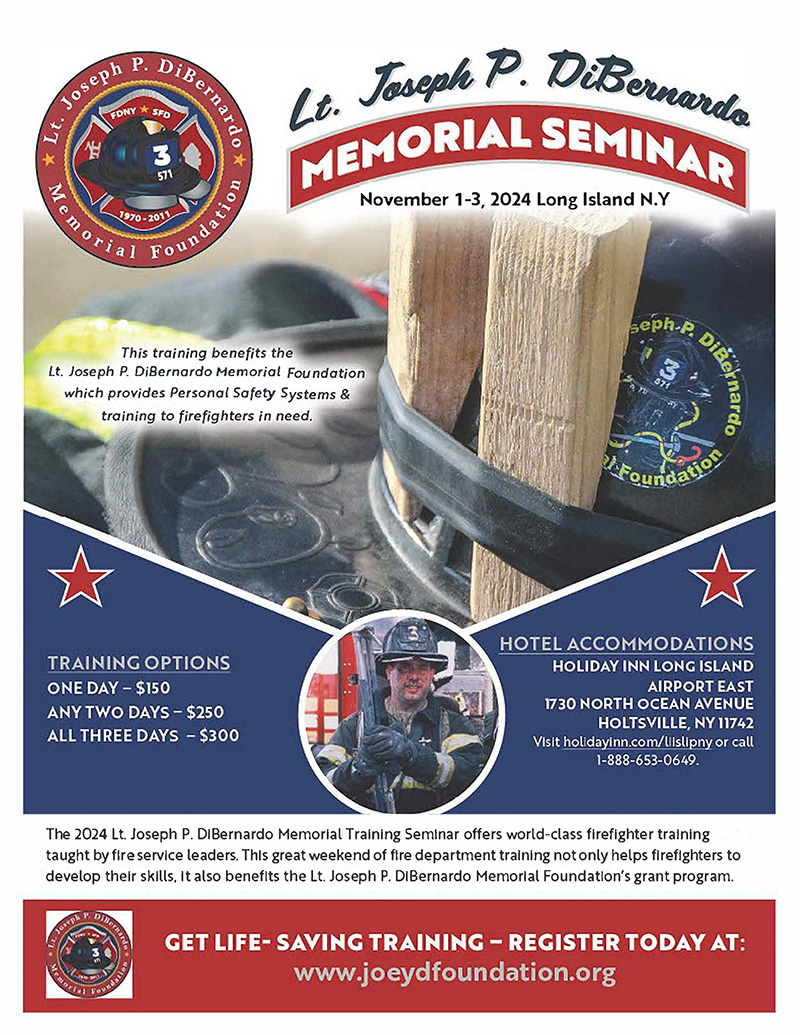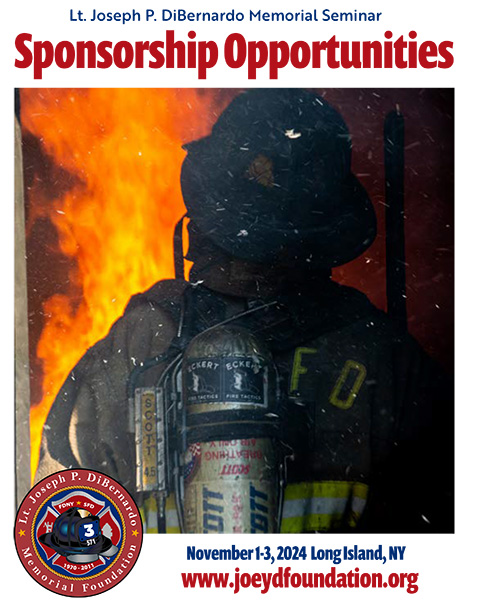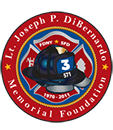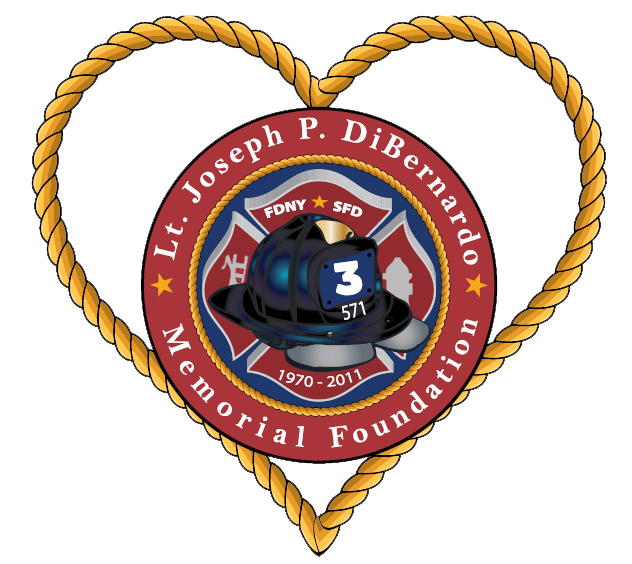- 1-855-4JOEYDI / 1-855-456-3934
- This email address is being protected from spambots. You need JavaScript enabled to view it.
The Lt. Joseph P. DiBernardo Memorial Training Seminar included three days of life-saving firefighter training!
The 2024 Lt. Joseph P. DiBernardo Memorial Training Seminar offered world-class firefighter training taught by fire service leaders. This great weekend of fire department training not only helped firefighters to develop their skills, it also benefited the Lt. Joseph P. DiBernardo Memorial Foundation’s grant program. Our grant program helps fire departments in need provide Personal Safety Systems (PSS) to their firefighters.
Download Flyer

Two Days Firefighter Hands-On Training
November 1 – 3, 2024
Suffolk County Fire Academy
676 Maple Street
Yaphank, NY 11980
One Day World-Class Firefighter Lectures
November 3, 2024
Eastern Suffolk Boces
750 Waverly Ave
Holtsville NY 11742
Training Options
ONE DAY – $150
ANY TWO DAYS – $250
ALL THREE DAYS – $300
Hotel Accomodations
HOLIDAY INN LONG ISLAND/ AIRPORT EAST
1730 NORTH OCEAN AVENUE
HOLTSVILLE, NY 11742
Sponsorship Opportunity

Join us for another year of hands-on training at the 2024 Lt. Joseph P. DiBernardo Memorial Training Seminar. All hands on training programs require a minimum certification of Firefighter I.
Train for your next response with hands-on opportunities including:
Full Day Programs
Residential Fire Operations with OSTA – Full Day Program
Lead Instructor: On Scene Training Associates (OSTA) Aaron Heller Hamilton FD NJ ret.
This program is designed to enhance firefighter’s skills at the scene of Residential Fires. Instructors from OSTA will be passing on knowledge through a rotation of skills some of which include; Hose handling, Access and Egress, Forcible Entry, Saw Operations, Laddering, VEIS, Search and Communications. Attendees will definitely build on their current knowledge and skills while learning new tricks of the trade by some of the best instructors from around the Country.
Elevator Rescue Hybrid Ops – Full Day Program
Lead Instructor: Dragon Rescue Management Mike Dragonetti Stamford CT FD ret.
This full day program is designed to enhance the firefighter awareness and knowledge with elevator emergencies and rescue. Students will have an interactive classroom discussion on hazards involved when dealing with various elevators, various techniques that should be utilized and how to keep everyone safe during these responses. Once the classroom program is completed the students will be guided to various types of live elevators in a high rise building to review lessons discussed and taught in the classroom. Instructors from Dragon Elevator Management and elevator companies will guide the student safely during this program.
Half Day Programs
Residential Fires - Live Fire
Lead Instructor: SCFA Instructors
Firefighters will perform various evolutions designed to develop skills on the fire ground at residential structure fires. Many skills will be taught and performed including; Hose handling, Forcible Entry, Laddering, VEIS, Search and Communications. There will be live fire with smoke and heat conditions in the County burn building with seasoned instructors guiding you through each evolution.
Commercial Fire Operations - Live Fire
Lead Instructor: SCFA Instructors
Firefighters will perform various evolutions designed to develop skills on the fire ground at commercial structure fires. Many skills will be taught and performed including; Hose handling, Forcible Entry, Laddering, VEIS, Search and Communications. There will be live fire with smoke and heat conditions in the County burn building with seasoned instructors guiding you through each evolution.
Fire Behavior for the Modern Fire Environment
Lead Instructor: FlashFire Industries Dan Gordon FDNY
This isn’t just about flashover and the modern fire curve! This course is designed for the firefighter to increase their knowledge on what is actually happening around them in a fire building. The course will begin with a short classroom presentation followed by a rotation of live burns that demonstrate each and every aspect of the presentation under real fire conditions. Students will see firsthand changes on the fire ground including; fire growth, proper and improper ventilation, oxygen limited fires, roll over, flashover and more! Students will also operate with a Thermal Imaging Camera and proper use of the CAN!
Forcible Entry
Lead Instructor: East Coast Rescue Solutions Chris Minichelli FDNY
Firefighters encounter many obstacles when trying to enter in to a fire building to save lives and get water on the fire quickly and efficiently. This program is designed to enhance firefighters’ skills on forcing doors, cutting locks and roll down doors to enter as quickly as possible. Various tools and techniques will be addressed by experienced instructors from East Coast Rescue Solutions.
Advanced Forcible Entry
Lead Instructors: Captain Bob Morris FDNY ret.- Chief Stamford CT FD and Captain Rex Morris FDNY
Access and egress to structures is a constantly changing and challenging encounter for firefighters. Security is a top priority to some businesses and even some residential homes are becoming more difficult. This program is designed to challenge students with basic entry to more advanced environments. Different techniques and tools will be used including “the Irons”, Bunny tool and Saws. The program will finish off with students operating in zero visibility while forcing doors.
FIREFIGHTER DOWN – RIT/Firefighter Rescue with FAST Rescue Solutions
Lead Instructor: FAST Rescue Solutions Eric Allen Philadelphia FD
This course is designed for the Firefighter and Fire Officer to enhance their ability to operate proficiently as a Rapid Intervention Crew. Students will go through various stations utilizing different equipment and rescue techniques in zero visibility to save our own. The following skills will be covered Air Management, Emergency Communications, Downed Firefighter Removal Techniques and Self-Survival Skills.
Brass Tacks and Hard “ER” Facts
Lead Instructor: Jerry Herbst & Elkhart Brass
This 4-hour course will take you behind the scenes of the making of the Brass Tacks & Hard Facts engine company training video series and beyond the facts presented. It will be a deep dive into the gamut that is the engine company discipline, specifically, heightening awareness to the various types of equipment that create fire streams and developing a basic understanding of the different types of equipment in use today. It exposes the following critical factors contributing to success of the firefighter interaction with this equipment: Flow, function, relationship of pressure to GPM and limitations due to nozzle reaction.
“Be That Guy!” – Saving Yourself & Others
Lead Instructor: Battalion Chief John Cagno North Providence FD & Captain Tony Tricarico FDNY ret.
This class is designed to give firefighters techniques and simple actions to save yourself, or another member in a rapid manner using just the common tools and basic equipment carried by members on the fire ground. This is not a RIT operation; this is about keeping yourself and/or your crew alive. Students will be shown and then challenged to perform various techniques that you may encounter on the fireground.
Standpipe Operations
Lead Instructor: SCFA Instructors
Not all standpipe operations are performed in the same way. This course is designed to teach proper methods of utilizing a standpipe system, hooking up, stretching hose lines and operating in large and multi-story structures. The course will begin with a classroom presentation followed by hands on operations in a multi-story structure. Instructors will work with students on tasks that are constants and that will always be performed before firefighters advance a hose lines into the harm's way.
High Stress Operations – Classroom Only
Lead Instructor: Captain Ralph Longo FDNY – Nassau FSA
What is your mental mindset while responding and operating during challenging events? This program is designed to look at the various forces that are applied and exerted to firefighters (both internal and external) during traditional forcible entry and search. The mental component sometimes goes unchallenged, yet part of managing a pressure situation is managing yourself. Here, the firefighter will be tasked with spotting potential friction points and will identify strategic moments to implement a “tactical pause” as routine, in the form of various performance skills and stress inoculation strategies designed to increase resiliency and the likelihood of sustained success.
Tactical Actions Before a Last Resort Bailout
Lead Instructor: All Hands Fire Equipment & Training Don Colarusso
Firefighters place themselves at great risk while performing their job on the fireground. Searching for life and fire, searching the floor above, being placed in untenable conditions – these and many other positions require firefighters to be smart aware and ready to act. Firefighters must always have a sense of “situational awareness” and the ability to understand the environment conditions as they change and evolve. Having “Hazardous Recognition” offers the ability to quickly react when you may have seconds to make a move.
Heavy Lifting/Advanced Stabilization
Lead Instructor: Paratech Robert O’Donald & Jason Bernfeld
This class is design to challenge the firefighter with difficult extrication scenarios that are not every day occurrences. Vehicles are staged in precarious positions with viable victims trapped that must rely on proactive firefighters to save them. Students will use various tools and equipment while utilizing proven techniques under the guidance of seasoned instructors to successfully extricate the victims.
Pumping Operations
Lead Instructor: Chris Howard FDNY – Nassau FSA
The fire service has experienced many changes in how we operate over the past 50 years- Bunker gear, thermal pane windows, SCBA usage. Some of these changes have been identified as they were happening and training was changed in order to keep up. The transition from a throttle and relief valve set up, to a pressure governor on our engine companies was one of these changes. A paradigm shift is needed for an Engineer to properly supply handlines on the fireground. We will go more in depth to explain some of the common mistakes made on the fireground and teach why this continues to happen. This class will explore the differences in the process to properly supply and pressurize handlines on the fireground. The difference between pressure and volume in a two-stage pump, as well as identifying nozzle reaction as an issue in some cases. Teaching our chauffeurs to understand how the pressure governor works through engine cues, relationship of gauges, identifying how much volume of water is available, and the difference between using tank water or a positive water source are all identified and explained. The class will also give the student the knowledge to choose between the backstretch or inline pumping, depending upon hydrant location and manpower availability, as well as the knowledge to choose the proper intake in order to leave the front of the building clear for aerial apparatus. The hands-on portion will take all of the concepts explained and show the student in a real-world situation how the pressure governor behaves in multiple scenarios, and allows the student to operate and learn.
Lithium Ion Battery Fires
Lead Instructor: Envista Forensics Brad Davis & Randy D’Arcy
Battery fires have been increasing in the last few years and have become a hot topic for firefighters, local governments and code officials. Firefighters have been faced with quick intense fires and sometimes rapidly intensifying fires and explosions while operating. This course will surely enhance your knowledge of how these batteries work, cause fires and how to operate accordingly. The program will start with a baseline of information in the classroom and then out to the field where the instructors will show you how these batteries ignite and burn.
Engine Company Operations – Hose and Handlines
Lead Instructor: Lt. David Quick & Jerry Herbst
Not all hose line operations are performed in the same way. This course is designed to teach proper methods of selecting the proper lengths of hose lines, hooking-up, stretching hose lines and operating in stairwells and multi-story buildings. The course will consist of hands on operations in a multi-story structure. Instructors will work with students on tasks that are constants and that will always be performed before firefighters advance a hose lines into the harm's way.
Basement Fires/Flashover
Lead Instructor: SCFA Instructors
Just stretching a hose line into a basement is not always as easy as it seems! Students will be rotated through to challenge the engine company firefighter and enhance their knowledge on the importance of getting the line into operation quickly and efficiently. Students will be stretching 1 ¾’ and 2 ½” lines around obstacles and operating in live fire conditions. Students will operate hose lines at a basement fire under live fire conditions and learn how fires rollover and flashover in the Flashover Simulator.
“On the Other Side” The VES Mindset
Lead Instructor: New York Truck Work – Kirk Smith FDNY ret.
This class will teach you VES Tactics so you can effectively “Vent Enter Search” aggressively while looking for a life hazard. You must adopt a mindset and preparation into doing VES. As a trained professional you should be focused on increasing the chances of survival for the victim.
Students existing techniques will be enhanced as they become more confident in their ability to perform VES during our training class. Topics & Tactics covered include Size Up, Communication, Proper Tools, Ladder Work, Venting, Isolating, Search Techniques and Removal of Victims. Hands On Training with Stations and Scenarios.
This class is designed to enhance the ladder company firefighter enhance their knowledge and skills on working safely, but aggressively on the fire ground. Firefighter will learn various techniques on Forcible Entry, portable ladder & VEIS, low visibility search and roof operations.
Setting Up for Success – Tower Ladder Operations
Lead Instructor: Battalion Chief Chris Eysser FDNY – Nassau FSA
This program will provide the answer to why we consider the tower ladder both an offensive and defensive tool on the fire ground. The basic steps of how to use this tool to its maximum capability will be presented in an organized approach from start to finish. The program will emphasize the importance of getting this apparatus in position early and the advantages it can provide the department throughout the incident. This interactive presentation will have various discussions and then move out to the training field to set up and operate tower ladders on the buildings to be used at their maximum potential.
High Rise Fires & Operations
Lead Instructor: TBD – with SCFA Instructors
This comprehensive course is designed to equip firefighters with specialized knowledge and skills required for effectively managing high-rise fire incidents. Participants will learn about the unique challenges presented at high-rise structures including fire behavior, building construction and the complexities of evacuation and rescue operations. The course covers advanced firefighting techniques, the use of standpipe and sprinkler systems and strategic coordination with building management and other emergency responders. Through a combination of classroom instruction and practical exercises, firefighters will develop the expertise needed to handle high-rise fires safely and efficiently, ensuring the protection of life and property in these complex environments. This course is ideal for firefighters of all experience levels who seek to enhance their capabilities in high-rise fire operations.
Truck Company Roof & Outside Vent Operations
Lead Instructor: Chief Mo Davis Houston FD TX
This course aims to equip firefighters with the essential skills and knowledge required to perform critical roof & outside vent operations safely and effectively. Whether you are a seasoned veteran or a newer firefighter you will learn or enhance your knowledge from experienced instructors. Students will work through different skills understanding the importance of coordinating ventilation with inside operations, power saw operations, basic hand tools, laddering and proper size up for safe operations. This program is designed to ultimately enhancing their capabilities as an effective and skilled member of a truck company.
Technical Rescue Programs
Tower Rescue
Lead Instructor: All Hands Fire Equipment & Training with Capital Tech Rescue
Fire departments respond to various emergencies involving workers that are injured or stuck in an elevated position that must be removed safely. This program will enhance the technical rescue firefighter on Tower Rescue and will have students perform various techniques to climb a 100’ radio tower and remove an injured worker. Students will be guided by experienced instructors.
Man vs Machine - Industrial Rescue
Lead Instructor: PL Vulcan Battalion Chief Mark Gregory FDNY
Whether it is a basic ring removal, a person with their arm stuck in a snow blower or a full entrapment involving agricultural equipment, our instructors will guide you through the necessary steps to perform these extrications. Students will perform safe removal operations at different skills stations with basic equipment.
Trench Rescue
Lead Instructor: RPM Rescue Captain Mike O’Hare Houston FD
Trench and excavation rescues are extremely dangerous emergencies that can happen anywhere and at any time. This program is designed for firefighters trained in technical rescue, work in a support roll or are interested in being on a technical rescue trench team. Students will discuss the hazards of these operations, utilize various equipment and remove a victim from a trench.
Confined Space Rescue
Lead Instructor: RPM Rescue Captain Mike O’Hare Houston FD
60% of would be rescuers die when attempting to rescue a worker in a confined space. This program is designed for the technical rescue firefighter to enhance their knowledge of confined space emergencies. Various techniques will be shown and performed by the student in our confined space simulator. This is a great opportunity to complete your annual refresher or enhance your skills with experienced instructors.
High Angle Rope Rescue
Lead Instructor: RPM Rescue Captain Mike O’Hare Houston FD
Rope Rescues are becoming more and more common with the amount of taller buildings and older buildings that are in need of repairs. This program will give students the opportunity to perform actual rescues from an elevated position. Students will learn various techniques and perform raises and lowers of victims in distress including window washers trapped by a dangling scaffold.
2024 Joey D Seminar Lecture Descriptions
Lecture Series
Keynote Speaker –
Lieutenant Michael Ciampo FDNY ret.
“FIRE ACADEMY TO THE FIRE FLOOR: WHY THE DISCONNECT? “
Lieutenant Mickey Farrell FDNY
Confronting a dilemma that has plagued the fire service for decades, the old mentality of "you'll learn that in the firehouse" has set young, motivated firefighters up for failure. Unfortunately, not every firefighter can be part of an organization rich in pride, tradition, and training.
This class aims to bridge the gap for lost firefighters trying to find their way and senior firefighters looking for a renewed passion for their job. We will cover everything from your first day to your first fire and every subsequent fire throughout your career. By connecting the dots, this class will provide valuable insight and training to help you succeed in your career as a firefighter.
"SURVIVING THE JOB”
Lieutenant Steve Gillespie FDNY ret., Current Battalion Chief Goose Creek S.C.
Mental health in first responders is somewhat of a taboo topic in the careers of EMS, law
enforcement, firefighting, and telecommunicators alike. Post-Traumatic Stress Disorder is a silent injury that is still not discussed as openly as it should be. Steve will share his story of how he has gone beyond his PTS diagnosis to PTG (Post Traumatic Growth) with the help of therapy, medication, and becoming a peer counselor. “Surviving the Job” is Steve’s story of over 39 years as a first responder. Starting as a 17-year-old volunteer firefighter to the events of September 11, 2001 and the Black Sunday fire, Steve offers his story with others hoping they realize that there is no longer a stigma with being in pain. Gone are the days of "suck it up kid" and "we don't talk about that stuff". Talking helps empty "the box" of stored up trauma and images before it can overflow and affect you and your home life. This is not a scientific study or research but Steve’s very personal story and how he has "Survived the Job". Steve’s poignant story promises to be valuable to firefighters, other first responders, peer team members, and clinicians serving in the emergency services world.
“TOP FLOOR FIRES”
Lieutenant Michael Scotto FDNY ret.
All fires have similarities. At a top floor fire, there are issues which are always present which can increase the inherent dangers faced. Extension is a concern at most structural fires, but a top floor job has a few more imminent issues. Roof stability and design, the construction type, what is above us, or simply the length of the stretch can complicate matters. Escape can be extremely difficult. Do we have ladders placed, if ladders cannot reach us, do we have a PSS, if not what are my options? This lecture will investigate these and other issues concerning operations and the problems we will encounter. Occupancies change our strategy and tactical decisions. Whether occupied, vacant, residential (MD, PD), commercial, manpower, water supply, legal, or illegal occupancies, guide our operations. Are we prepared for new technologies or the bath fitter mentality? How do rehabs change how we operate when combined with the original structural components. We will discuss these and other concerns by also tapping into your experiences. Sharing knowledge is necessary for the safety of all.
“THE ANATOMY OF AN APARTMENT HOUSE FIRE”
Deputy Assistant Chief John Norman FDNY ret.
This class focuses on one of the deadliest fires in America for civilians - Fires in Apartment Houses or Multiple Dwellings (MD’s). The class is approximately 90 minutes in length and includes; Construction Deficiencies Related to Fire Spread, Fire Attack, Hoseline Selection, Placement and Water Supply, Search and Rescue- Vent, Enter, Isolate and Search (VEIS) and Fires in Voids: Shafts and Cocklofts. Emphasis is placed on developing workable tactics that your organization can implement on the Fireground under a variety of common, and not so common, conditions.
Thank You to the Suffolk County Fire Academy for their continued support of the Lt. Joseph P. DiBernardo Memorial Training Seminar.


